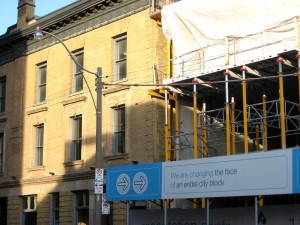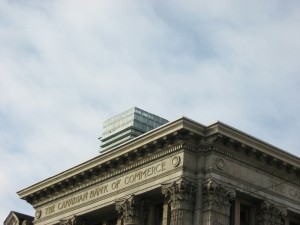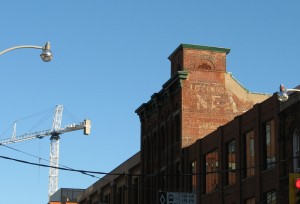Infiltration
by Patrick – No comments. The post is really that bad, huh?
 I’m veering away from my regular existential indulgences for a bit to wax oracular about a highly visible trend around the sprawl: the influx of permanent influences that will change, and are changing, the face of city.
I’m veering away from my regular existential indulgences for a bit to wax oracular about a highly visible trend around the sprawl: the influx of permanent influences that will change, and are changing, the face of city.
None of this will even begin to approach news for most Torontonians.
The slow and stealthy creep of Metro stores over the past few years as the company gobbled up A&P/Dominion, Loeb, and other grocery stores, was clearly visible even as it came as a bit of a surprise to locals (that was my impression anyway). The re-branding was simply a facelift on a done deal, but it threw light on a trend which is continued by extra-Torontonian projects such as the Ritz-Carlton Group’s Ritz Residences, the Maned One’s Trump Tower, and even the sweet and matronly franchise of Chez Cora’s.
This isn’t even anything that’s new or unique. Walmart’s been blighting the burbs for years and Starbucks has become so ubiquitous that one recently opened in my living room.
What makes the changes happening now different is the fact that they involve the take-over of at least a block (or more) of prime downtown real estate and, more often than not, a razing and complete rebuilding on the site. Unlike a simple facade or signage appended to part of a lot’s building, the entire lot is being transformed. It’s not that these external influences are simply appended to the fabric of Toronto, they become the fabric of Toronto. In other words, people who neither live here nor spend much time here are guiding the development, look, and feel of Toronto.
Everyone knows that generalizations suck, so let’s not do that here. There is a lot of city-borne development going on and even if some are of these projects aren’t Torontonian, at least they’re Canadian.
Cora’s influences on Toronto, for example, have been to broaden the breakfast experience and give permission for thriving businesses to come across as local and quirky. Although the company is expanding quite quickly, Cora’s locations are mostly appropriated ones. The restaurant is a blush of Montreal colour on the broad palette of Toronto.
The Ritz and Trump Tower, however, are much more direct. In these cases, even if the building’s ownership changes to Canadian hands, many of the characteristics of U.S. design, U.S. ownership, and U.S. management will remain. The architectural style will definitely stick around for a few generations and, although the buildings will become part of the Toronto skyline, they will remain at heart un-Torontonian.
 I’m not saying that this is necessarily a bad thing.
I’m not saying that this is necessarily a bad thing.
Toronto is superbly racially and culturally mixed and, unlike the necessary Americanization of immigrants south of the border, here you can spend your entire life in the isolation of your own culture (whatever that happens to be). Immigrants have left their mark on Toronto since day one, but the majority of the city is built on Edwardian ideals. Stores may have Cantonese signage, but this is often affixed to confederation-era (or analogous) buildings.
The new mega-developments that are springing up around town in increasing numbers are removing these colonial vestiges, but not with anything that is uniquely Torontonian or even Canadian.
The general stance taken against all of this is that new architecture is removing the beauty and uniqueness of Toronto along with its history. Change, goes the argument, is slowly eating away at the city. What this seems to forget, however, is that change is sometimes a catalyst for improvement.
The modern city of Paris, for example, only became one of the jewels of Europe when Napoleon decided to completely raze it and re-build it from scratch. If the occasional city block bothers critics now, old Parisian revisions would have driven them insane.
That’s not to say that this is all a good thing either, but I’m hardly qualified to make a judgment either way. Like Paris, only time will tell what these big changes bring. However, it’s not the changes themselves but their influences that make this such a unique moment in history.
Most major urban renovations have been, up until maybe the last one-hundred years, fairly isolated. In GTA suburbs this is still mostly true, but also with a characteristic that sets them apart. A hundred years ago, urban buildings were built locally and were also, for the most part, unique. Today’s urban buildings are unique but not, as mentioned, always built or owned locally. Suburban communities are mostly built locally, but uniqueness isn’t a prominent (or sometimes present) feature.
I think that the suburban trend is horrendous, not only for the lack of uniqueness or character, but also for the deep environmental, social, and cultural impacts such communities have.
 The urban trend, however, is a bit more hazy. There’s no indication that it will abate any time soon so it’s reasonable to expect more xenophilic ownership, development, and cultural influence into the future. With big names like Ritz-Carlton and Trump jumping into the game, an increased American role in urban re-development is quite likely.
The urban trend, however, is a bit more hazy. There’s no indication that it will abate any time soon so it’s reasonable to expect more xenophilic ownership, development, and cultural influence into the future. With big names like Ritz-Carlton and Trump jumping into the game, an increased American role in urban re-development is quite likely.
What this means is that, unlike any other era in urban planning or development, Toronto (and I suspect many other North American cities as well) will be facing an even greater crisis of identity — if you buy the notion that we already have an issue in this area. Many of the facts used to support this belief also incorporated the changing downtown environment as proof of a disappearing culture (not that anyone can clearly define what that culture is). In the past I would’ve used the Parisian counter-argument to moot that point.
With truly non-Torontonian influences carving out great swathes in the city’s make-up, however, they have more solid footing for their complaints. Then again, Trump Tower could be the greatest thing ever to happen to this city and may help to add some edges to that definition of what it means to be a Torontonian.




What's on your mind?